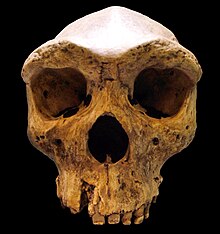14°27′36″S 28°25′34″E / 14.460°S 28.426°E
 Replica (Museum Mauer, Germany) | |
| Common name | Kabwe 1 |
|---|---|
| Species | Homo heidelbergensis (Homo rhodesiensis) |
| Age | 324-274 ka |
| Date discovered | 1921 |
| Discovered by | Tom Zwiglaar |
Kabwe 1, also known as the Broken Hill skull and Rhodesian Man, is a Middle Paleolithic fossil assigned by Arthur Smith Woodward in 1921 as the type specimen for Homo rhodesiensis, now mostly considered a synonym of Homo heidelbergensis.[1]
The cranium was discovered in Broken Hill mine, a lead and zinc mine in Northern Rhodesia (now Kabwe, Zambia) on 17 June 1921[2] by Tom Zwiglaar, a Swiss miner; and an African miner whose name was not recorded.[3] In addition to the cranium, an upper jaw from another individual, a sacrum, a tibia, and two femur fragments were also found. The skull was dubbed "Rhodesian Man" at the time of the find, but is now commonly referred to as the Broken Hill skull or the Kabwe cranium.
The skull is kept in the Natural History Museum, London.[4]
- ^ Hublin, J.-J. (2013), "The Middle Pleistocene Record. On the Origin of Neandertals, Modern Humans and Others" in: David R. Begun (ed.), A Companion to Paleoanthropology, John Wiley, pp. 517-537 (p. 523).
- ^ Chambo Ng'uni (2015-01-10). "Zambia resolute on recovering Broken Hill Man from Britain – Zambia Daily Mail". Daily-mail.co.zm. Retrieved 2018-06-04. "Records at Kabwe Municipal Council reveal that the skull was discovered in Mutwe wa Nsofu area during mining excavation. The cave where the remains were found seemed to have served as a shelter and camping place for the early man. Animal bones were also discovered and they represented the remains of meals and these were predominantly of antelope. Having been discovered at Broken Hill Mine where mining started around 1904, the skull was later named Broken Hill Man. The skull was complete and its features were recognizable. It had a round perforation of the borne that could have been caused by a wooden pointed spear. Discovered along with the skull were parts of the face of the second individual, a thigh bone, shin bone, part of the bones of the pelvis, a sacrum, part of the bone of the upper arm, a quantity of animal bones, some stones and primitive bone implements."
- ^ Balter, Michael (2019-02-18). "Zambia's Most Famous Skulls Might Finally Be Headed Home". www.theatlantic.com. The Atlantic. Retrieved 2019-02-18.
- ^ "Collections - Natural History Museum". www.nhm.ac.uk.